The Bokashi system of composting is an anaerobic (without air) system of composting. It utilizes the services of different microbes than are found in your well turned compost heap or bin.
Bokashi is, essentially, a fermentation system. It has more in common with sauerkraut and the dark, wet bad smelling organic material that sits in waterlogged areas and unturned bins. Saying that makes it sound bad, but I thought I’d get that idea out of the way.
Yes, it does contain anaerobic microbes, but the Bokashi system is designed for indoor use and has much less smell than the traditional kitchen scraps bucket that may be sitting by your sink right now. It attracts fewer flies too, as it is sealed and airtight. Actually, it is safe to say that it doesn’t attract flies at all… when closed.
Added to those benefits is the fact that it can handle meat and citrus. Actually, the claims I saw for that are a bit exaggerated. The claim that it handles meat seems due more to that fact that the lid is closed most of the time and the meat buried in lots of fresh smelling (?) scraps.
So, what is the best way I’ve found to ‘do’ Bokashi? Here’s my method…

The Maze Indooor Composter was the only kit available at the local hardware store, but I’m happy that I bought one. It’s made from a tough plastic, has a strong handle and well fitting lid, and a sturdy, easy to turn tap. Inside it has a perforated tray and comes with a scoop a presser.
To make your Bokashi compost using Bokashi Bran –
Start by moistening the bin, then add a couple of scoops of Bokashi bran

Add a layer of scraps. Make sure they’re well mixed. The Bokashi system handles citrus and meat better than aerobic composting. Make sure they’re packed tightly to expel air wherever possible.
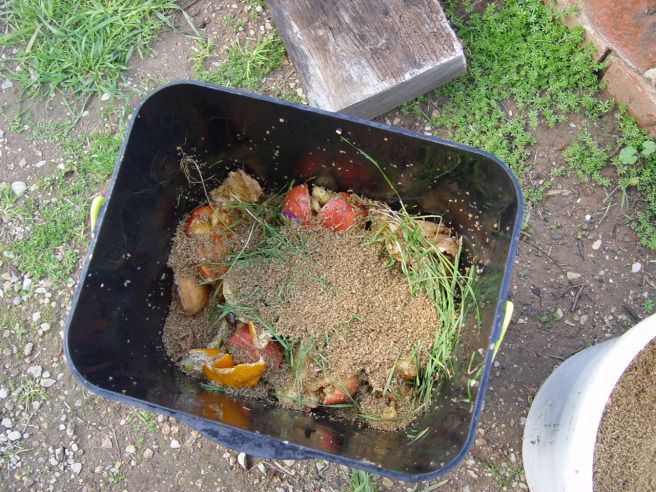
When the scraps have been placed in the bin, add a scoopful of Bokashi bran to it. If you have the Bokashi EM1 liquid, a couple of sprays of this will do instead of the bran. I find the bran better to use, plus I can make it myself (I'll be doing a post on this soon).
The last step when adding scraps and bran is to push down the mix. This helps expel air and gets the microbes in contact with the scraps and presses out liquid.
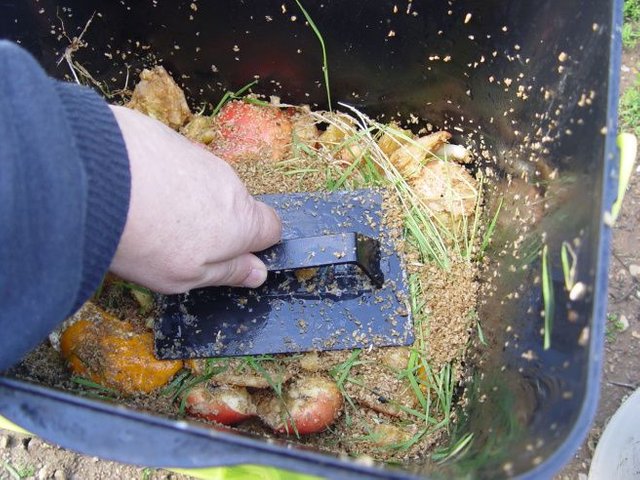
Bokashi composting is an anaerobic system, so it is best to expel as much air as possible from the bin. I keep a week or so worth of bran in a Ziploc bag on top of the scraps to help fill the space. One benefit – as the level of the scraps gets higher, the bag gets emptier and takes less space.
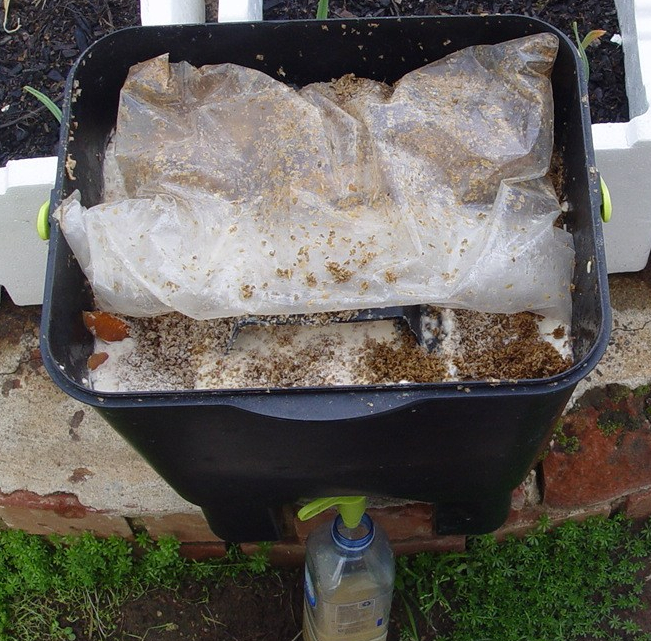
As I mentioned before, the Bokashi compost needs a little time before adding it to the garden, compost heap, or the worms. Generally, it must sit for a week or so before using it for its next application.
I keep two 20 liter buckets to put my Bokashi in. I fill one from a couple of Bokashi bins as they fill up. It usually takes two weeks to fill one of the white buckets at our normal level of 'production'.
When the first bucket is full, I start on the second. In the warmer weather the two weeks that this takes to fill is enough time to let the first bucket ‘mature’. I empty this bucket to where it must go, give it a good hose out and start filling this one when the next Bokashi bin is full. I don’t scrub it out with soaps or the like, as I work on the assumption that there’s always going to be some live micro-organisms left if I don’t.
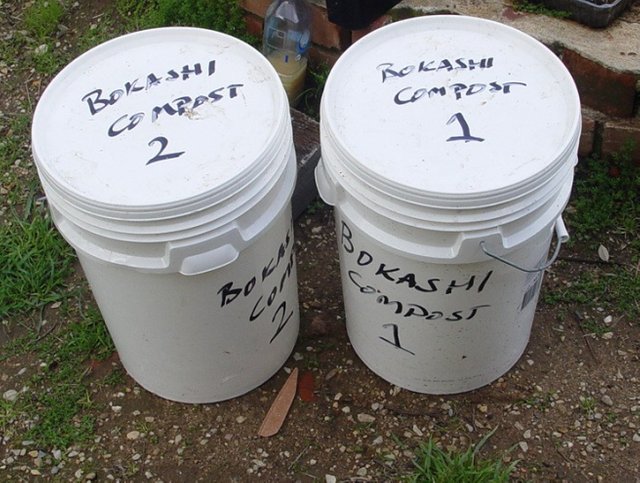
The liquid must be drained from the bin periodically or it can make the system too wet. It’s full of beneficial microbes and has a wide range of uses itself (I'll be doing a post on that soon too!).
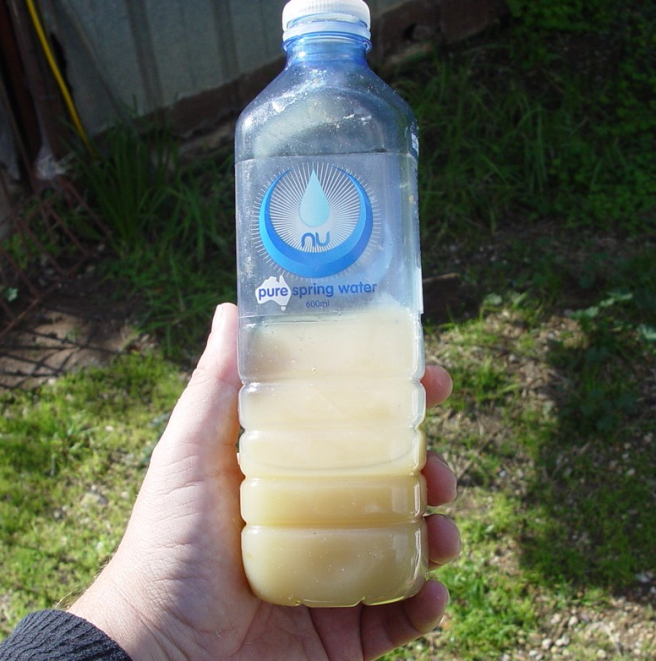
Find links to my other Bokashi posts on Steemit in this Bokashi Index Post
or check our more info on our blog
That really goes against the rules of traditional composting! It seems strange to be squeezing the air out.
Downvoting a post can decrease pending rewards and make it less visible. Common reasons:
Submit
It uses bacteria that don't like the oxygen to ferment the veggie scraps. I might just slip that into the post...
Downvoting a post can decrease pending rewards and make it less visible. Common reasons:
Submit
@cryptohustlin has voted on behalf of @minnowpond. If you would like to recieve upvotes from minnowpond on all your posts, simply FOLLOW @minnowpond. To be Resteemed to 4k+ followers and upvoted heavier send 0.25SBD to @minnowpond with your posts url as the memo
Downvoting a post can decrease pending rewards and make it less visible. Common reasons:
Submit
Wow. This is really informative. Composting is the way to go to reduce waste and improve your soil for sure.
Downvoting a post can decrease pending rewards and make it less visible. Common reasons:
Submit
Thank you.
Downvoting a post can decrease pending rewards and make it less visible. Common reasons:
Submit
This post received a 15% vote by @mrsquiggle courtesy of @choogirl from the Minnow Support Project ( @minnowsupport ). Join us in Discord.
Upvoting this comment will help support @minnowsupport.
Downvoting a post can decrease pending rewards and make it less visible. Common reasons:
Submit
@royrodgers has voted on behalf of @minnowpond. If you would like to recieve upvotes from minnowpond on all your posts, simply FOLLOW @minnowpond. To be Resteemed to 4k+ followers and upvoted heavier send 0.25SBD to @minnowpond with your posts url as the memo
Downvoting a post can decrease pending rewards and make it less visible. Common reasons:
Submit
@eileenbeach has voted on behalf of @minnowpond. If you would like to recieve upvotes from minnowpond on all your posts, simply FOLLOW @minnowpond. To be Resteemed to 4k+ followers and upvoted heavier send 0.25SBD to @minnowpond with your posts url as the memo
Downvoting a post can decrease pending rewards and make it less visible. Common reasons:
Submit
@cmtzco has voted on behalf of @minnowpond. If you would like to recieve upvotes from minnowponds team on all your posts, simply FOLLOW @minnowpond.
To receive an upvote send 0.25 SBD to @minnowpond with your posts url as the memo
To receive an reSteem send 0.75 SBD to @minnowpond with your posts url as the memo
To receive an upvote and a reSteem send 1.00SBD to @minnowpond with your posts url as the memo
Downvoting a post can decrease pending rewards and make it less visible. Common reasons:
Submit